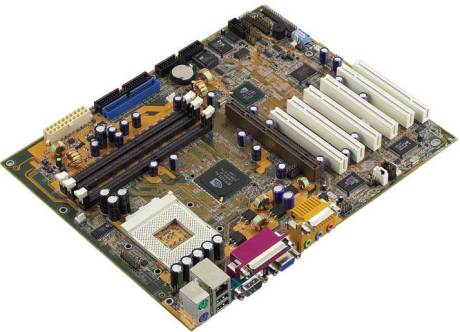Teknologi Komputer 1
TEKNOLOGI KOMPUTER (Pengenalan Komponen Komputer)
Untuk dapat memahami teknologi komputer, maka harus dipahami bagaimana komputer tersebut diklasifikasikan sebagai berikut:
- Spesifikasi Hardware
- Mesin Desktop
- Mesin ‘Server’
- Spesifikasi Software
- Sistem Operasi “Personal”
- Sistem Operasi “Network”
- Network / Jaringan Komputer
- System and Network administration
Dalam hal proses kerja komputer (computing) maka dapat dibagi dua yaitu
- Centralized (Tersentralisir)
- Distributed (terdistribusi)
Berdasarkan komponen mesin dari Komputer maka sebuah komputer dapat dibagi menjadi
• Processor(s) (CPU)
• Main Memory (RAM)
• Storage Space
– Hard Disk
– Floppy Disk / CDROM / DVD …
• Input / Output Devices
– Keyboard / Mouse
– Monitor / Graphics
• Communications Devices
– Network Interface Card
– Modem
• Motherboard
– Papan circuit utama di dalam PC, sebagai dudukan untuk processor, memory and expansion slots, dll.
– Koneksi langsung atau tidak langsung untuk setiap komponen di PC
– ‘Chipset’
• Group dari microcircuits yang mengkoordinasi arus dari komponen ke komponen lain di dalam sistem
• Contoh: Intel 815, 440BX,
Sangatlah
penting untuk kita pahami bahwa semua informasi yang dapat dibaca oleh
komputer menggunakan sistem binary yaitu bilangan 1 dan 0, untuk itu
diperlukan banyak instruksi agar dapat diterjemahkan kedalam informasi
yang dapat dibaca oleh manusia. Sebuah binary digit (1 or 0) disebut bit dan grup dari 8 bits disebut byte. Untuk kelanjutan dari sistem binari akan dibahasa pada mata kuliah sistem komputer.
Prosesor
dan Memory merupakan dua komponen yang menjadi daya tarik utama untuk
sebuah Komputer, sehingga bahasan saat ini lebih banyak ke arah dua
komponen tersebut.
PROSESOR
Prosesor
adalah yang mengatur operasional dengan range terbatas untuk melakukan
aritmatik, membandingkan angka dan mengelola input/output (baca
informasi, tampilkan dan simpan)
Semua
program komputer dibangun dari urutan instruksi dasar seperti
operasional perhitungan primitif. Prosesor yang melakukan perhitungan
dan membuat komponen-komponen dapat berfungsi dengan sistem
–Arithmetic Logic Unit (ALU)
–Control Unit (CU)
ALU membawa operasional aritmatik dan operasional logika sementara itu CU mengendalikan jalannya instruksi.
Prosesor
sangan sedikit memiliki ruang untuk penyimpanan (<100) dan ruangan
ini disebut register. Penyimpanan informasi inilah yang dibutuhkan ALU
dan CU. Register ini sering disebut sebagai 8, 16, 32 atau 64 bits.
Sebuah prosesor dengan register untuk penyimpanan n-bits disebut b-bit
prosesor, contoh saat ini adalah pentium 4 dengan 32 bits prosesor.
Prosesor dapat diklasifikasikan berdasarkan ukuran register dan disebut dengan klasifikasi bus size, pengertiannya adalah jumlah dari bits data yang dapat dikirim dalam satu kali jalan.
CPU clock adalah yang mengendalikan rate aktivitas yang dapat di bawa CPU. Perkembangan
urutan dari putaran dan sebuah operasi yang dapat menampilkan satu kali
putaran. CPU clock diukur dengan satuan Hertz (Hz) dengan MHz dan GHz
yang saat ini menjadi standar.
Istilah-istilah yang ada di Prosesor
CISC and RISC
– Complex Instruction Set Computing
• relatively rich and sophisticated set of instructions by which to process data
• May need >1 cycle to execute 1 instruction
• e.g. Intel Pentium
– Reduced Instruction Set Computing
• limited instruction set
• most instructions processed within 1 clock cycle
• e.g. PowerPC, Sun SPARC
Cache
– A ‘store’ for recently used data
– Temporary storage of instructions and data
– Primary Cache (on-board, Level1)
• Memory on the processor
• Very fast
• Typical size 32-64 KB
– Secondary Cache (external, Level2)
• Cache memory on the motherboard
• Typical size 128 – 512 KB
MEMORY
• Random Access Memory (RAM)
•Volatile storage : apabila mesin mati maka informasi hilang
•Tipe dan Kecepatan yang membedakan untuk jenis
– Static RAM
– Dynamic RAM
– Synchronous Dynamic RAM
•Typical size in modern PC
–64 MB – …
•Memori
biasanya digunakan oleh semua sistem operasi dan hampir semua sistem
aplikasi yang dibuka langsung dengan menggunakan sistem operasi. Memori
digunakan untuk menyimpan program dan data yang digunakan oleh prosesor
sehingga sering disebut sebagai main atau primary memory.
Hard Disk
•Permanent Storage
–Information still available after machine is powered off
–Store documents, files, applications, system files, …
•Typical size
–10 GB upwards
•Different types
–Integrated Drive Electronics (IDE or EIDE)
•Small no. of devices
–Small Computer System Interface (SCSI)
•Large no. of devices
•More expensive
Other Storage
•Floppy Disk
–Capacity 1.2 MB
•Zip Drive
–Capacity 100 – 250 MB
•CDROM / CD-RW
–Capacity 640 MB
–Common in all machines (usually read-only devices)
•Digital Versatile Disk
–Capacity 4.7 GB upwards
–Suitable for video etc
•USB Memory Key (16MB – …)
Input Devices
•Keyboard
•Mouse
–Standard for desktop machines
–Different decision for laptops
•Touch pad
•Rollerball
•…
•Scanner
•Touch-Sensitive Screen
•…
Output Devices
•Graphics adapter
–Dedicated hardware in the computer that is responsible for the picture displayed
–Resolution – no. of ‘pixels’ than can be displayed
•Determines ‘sharpness’ of picture
•640 x 480, 1024 x 768, …
–Colour depth – no. of colours that can be displayed
–Video RAM
•store image
•4 MB – …
Output Devices
•Monitors
–Display device
–CRT devices
•Desktop machines
•14”, up to 24”
–LCD panel devices
•e.g. laptop displays
•‘flat screen’
•9” to 15” for laptop
•15” upwards for desktop
•more convenient, better display, but more expensive
–Must adhere to safety standards
Other Devices
•Sound card
–For sound processing
•Network Interface card
–To connect to a Local Area Network
•Modem
–To communicate through a phone line
•Universal Serial Bus
–New standard for connecting peripherals
–E.g. scanner, printer, digital camera, …
- Mesin Desktop
- Mesin ‘Server’
- Sistem Operasi “Personal”
- Sistem Operasi “Network”

Tidak ada komentar:
Posting Komentar